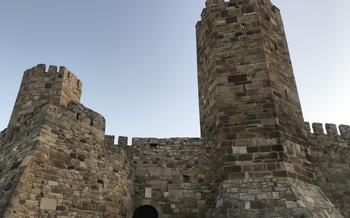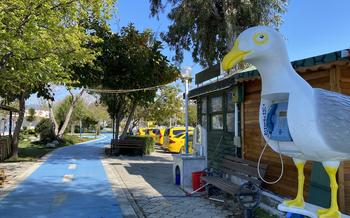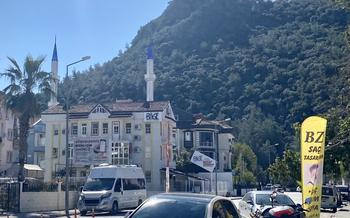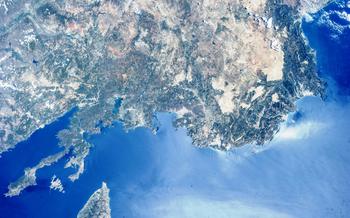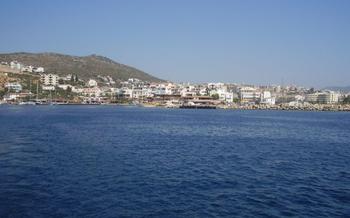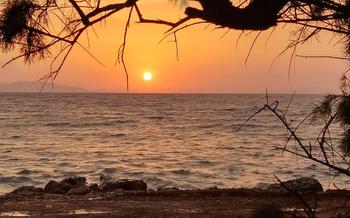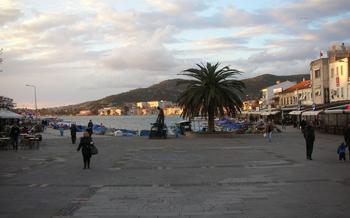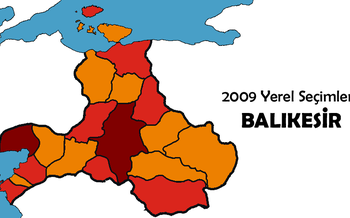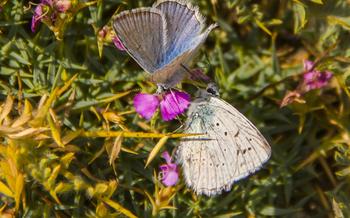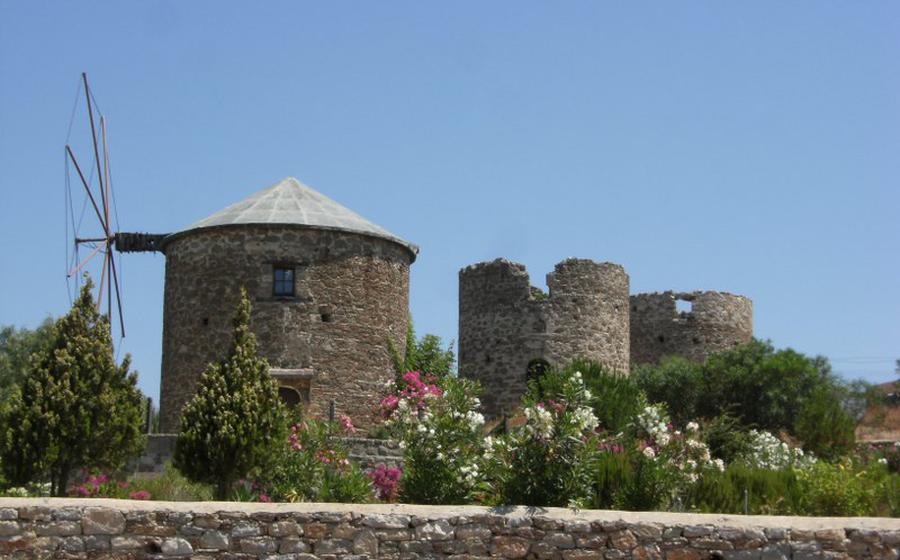
Datça Windmills
- Datça Windmills: A Historical Overview
- Location and Accessibility
- Panoramic Views from the Windmills
- Unique Photo Opportunities
- Visiting the Windmills: What to Expect
- Exploring the Windmill Interiors
- Local Crafts and Souvenirs
- Nearby Attractions and Activities
- The Village of Datça: A Culinary Delight
- Festivals and Events in Datça
- Accommodation Options in Datça
- Planning Your Visit: Tips for Travelers
- Best Time to Visit
- Packing Essentials
- Accommodation Options
- Responsible Tourism: Protecting the Windmills
- The Human Stories Behind the Windmills
- Insider Tip: Off-the-Beaten-Track Windmills
Datça Windmills: A Historical Overview
The windmills of Datça, proudly standing as silent witnesses to the town's rich history, are a testament to the ingenuity and resourcefulness of its people. Their journey began centuries ago, during the Ottoman era, when Datça was a thriving agricultural hub. Farmers, seeking an efficient way to grind their wheat and corn, turned to the power of the wind to ease their labor.
The architectural features of these windmills reflect a harmonious blend of functionality and aesthetics. Constructed from local stone and timber, they feature sturdy circular towers that taper towards the top, providing structural stability. The windmills are capped with conical roofs that rotate to catch the prevailing winds, maximizing their efficiency.
These windmills played a crucial role in the local economy, serving as the backbone of Datça's agricultural industry. They transformed the town into a flour-producing center, supplying the region with essential staples. The flour ground by these windmills not only sustained the local population but also contributed to the regional trade, showcasing Datça's agricultural prowess.
Location and Accessibility
The Datça Windmills are situated in the picturesque village of Datça, nestled on the southwestern coast of Turkey, facing the azure waters of the Aegean Sea. To reach this historical site, visitors can embark on a scenic drive through the winding roads that traverse the stunning Turkish countryside. The journey offers breathtaking views of olive groves, pine forests, and charming villages perched on hillsides.
For those relying on public transportation, regular buses depart from major cities like Marmaris and Dalaman, providing a convenient and affordable mode of travel. Upon arrival in Datça, visitors can easily navigate the village on foot, following the signs that lead to the windmills. The leisurely stroll takes approximately 15 minutes, allowing ample time to soak in the vibrant atmosphere and admire the traditional Turkish architecture.
Panoramic Views from the Windmills
The Datça Windmills offer breathtaking views of the Aegean Sea and the surrounding countryside. Perched atop a hill, these iconic structures provide a unique vantage point from which to admire the stunning scenery. On a clear day, visitors can gaze out over the turquoise waters of the Aegean, dotted with picturesque islands and sailboats. The lush green hills and valleys of the Datça Peninsula stretch out before you, creating a panoramic vista that is sure to take your breath away.
The best time to visit the windmills for the most stunning views is at sunset. As the sun dips below the horizon, the sky erupts in a kaleidoscope of colors, casting a warm glow over the landscape. The windmills, silhouetted against the vibrant sky, create a truly magical scene. Whether you're a photography enthusiast or simply someone who appreciates the beauty of nature, the panoramic views from the Datça Windmills are not to be missed.
Unique Photo Opportunities
The Significance of the Windmills as a Symbol of Datça
The Datça windmills stand as iconic symbols of the town, embodying its rich history and maritime heritage. These majestic structures are a testament to the ingenuity and craftsmanship of the local people, who harnessed the power of the wind to grind wheat and corn for centuries. Today, the windmills have become a symbol of Datça, attracting visitors from far and wide who come to admire their beauty and capture the essence of this charming coastal town.
Tips for Capturing the Perfect Instagram-Worthy Shot
Early Bird Gets the Worm: Arrive at the windmills early in the morning to beat the crowds and capture the magical hues of the sunrise. The soft, golden light will illuminate the windmills and create a breathtaking backdrop for your photos.
Drone Photography: If you're an aerial photography enthusiast, pack your drone and capture the windmills from a unique perspective. The elevated shots will showcase the panoramic beauty of the surroundings and provide a bird's-eye view of these architectural wonders.
Play with Angles: Experiment with different angles and vantage points to create dynamic compositions. Shoot from below to emphasize the towering height of the windmills or position yourself at a distance to capture the vastness of the landscape.
Include People: Incorporate locals or fellow travelers into your shots to add a human element and convey the scale and grandeur of the windmills. This will also give your photos a sense of life and authenticity.
Use Filters Wisely: While filters can enhance your photos, use them judiciously to preserve the natural beauty of the scene. Choose filters that complement the colors and tones of the windmills and the surrounding environment.
Visiting the Windmills: What to Expect
The Datça Windmills are open to the public from 9:00 AM to 5:00 PM, seven days a week. Admission fees are minimal, and guided tours are available for a more in-depth exploration of the windmills' history and operation. Visitors can also opt for self-guided exploration, allowing them to wander through the windmills at their own pace and capture stunning photographs.
Exploring the Windmill Interiors
Venturing inside the windmills is like stepping back in time and witnessing the ingenuity of the past. Each mill is a treasure trove of traditional techniques and mechanisms that were used to grind wheat and corn into flour.
As you enter, you'll be greeted by a large circular room that houses the millstones. These massive stones, often made of granite or basalt, are the heart of the windmill's operation. The lower stone, called the bedstone, remains stationary, while the upper stone, known as the runner stone, rotates above it.
The runner stone is attached to a vertical shaft that extends up through the roof of the mill. Wind power is harnessed through the sails, which are attached to a horizontal beam called the tailpole. When the wind blows, it catches the sails and causes them to rotate. This rotation is transmitted down the shaft, causing the runner stone to spin.
As the runner stone spins, it crushes the grain between itself and the bedstone. The resulting flour is then collected in a trough or bin below the millstones. The process is simple yet effective, and it has been used for centuries to produce flour for bread, pasta, and other food products.
In addition to the millstones, you'll also find other interesting features inside the windmills. There may be wooden gears and levers that were used to adjust the speed and direction of the millstones. There may also be sacks of grain or flour, as well as tools and equipment that were used by the millers.
Exploring the interiors of the Datça windmills is a fascinating experience that provides a glimpse into the history and ingenuity of these remarkable structures.
Local Crafts and Souvenirs
Celebrating the Ingenuity of Local Artisans
A visit to the windmills would be incomplete without exploring the treasure trove of local crafts and souvenirs available in the surrounding shops and stalls. These handmade creations not only serve as mementos of your time in Datça but also provide a tangible connection to the region's rich cultural heritage.
The village of Datça is home to a thriving community of artisans who pour their hearts and souls into creating unique and beautiful objects. From intricate pottery and hand-woven textiles to delicate jewelry and traditional wood carvings, each piece reflects the skill and artistry of its maker.
Immerse yourself in the vibrant colors and intricate designs that adorn these handcrafted items. Discover the stories behind each piece and learn about the techniques that have been passed down through generations.
By purchasing local crafts and souvenirs, you not only take home a piece of Datça with you but also contribute to the preservation of traditional skills and the livelihoods of these talented artisans. Your support helps sustain the local economy and ensures that these unique crafts continue to flourish.
So, take the time to browse the local shops and markets, engage with the artisans, and select a special souvenir that will remind you of your unforgettable experience in the land of windmills.
Nearby Attractions and Activities
The windmills are conveniently situated near a plethora of other captivating attractions and activities that await exploration.
-
Knidos: Embark on a captivating journey to the ancient city of Knidos, renowned for its well-preserved ruins, including an amphitheater, a temple, and remnants of a bustling harbor. Immerse yourself in the rich history and architectural wonders of this once-thriving metropolis.
-
Palampınar Beach: Bask in the sun's golden rays and the refreshing embrace of the Aegean Sea at Palampınar Beach. Indulge in swimming, sunbathing, or simply relishing the serene coastal ambiance.
-
Ovabükü Bay: Discover the idyllic Ovabükü Bay, a secluded paradise boasting crystal-clear waters and a picturesque shoreline. Dive into the azure depths for a snorkeling or scuba diving adventure, or simply unwind on the pristine sands.
-
Boat Tours: Embark on an exhilarating boat tour, setting sail from Datça Harbor. Explore hidden coves, secluded beaches, and picturesque islands, marveling at the stunning scenery and the pristine beauty of the Turkish coastline.
The Village of Datça: A Culinary Delight
Datça village, home to the iconic windmills, is not only a visual delight but also a culinary paradise. The village exudes a charming atmosphere, with narrow cobblestone streets lined with traditional Turkish houses, inviting cafes, and authentic restaurants.
A Culinary Journey Through Turkish Cuisine Datça's culinary scene is a celebration of traditional Turkish flavors, where fresh seafood and locally sourced ingredients take center stage. Visitors can indulge in a variety of dishes, from freshly caught grilled fish to savory kebabs and succulent mezes.
A Taste of the Sea Seafood lovers will be in heaven in Datça. The village's proximity to the Aegean Sea ensures a steady supply of fresh catches, which are transformed into mouthwatering dishes. Grilled octopus, calamari, and sea bass are just a few of the delicacies that await visitors.
Traditional Turkish Delights Beyond seafood, Datça's restaurants offer a diverse selection of traditional Turkish dishes that showcase the richness of the local cuisine. Mezes, an assortment of small plates, are a must-try, featuring delights such as hummus, baba ghanoush, and yaprak sarma (stuffed vine leaves).
Savor the Flavors of Datça Whether it's a leisurely breakfast at a cozy cafe, a long lunch break at a traditional restaurant, or a sunset dinner overlooking the Aegean Sea, Datça offers a culinary experience that tantalizes the taste buds and leaves visitors craving for more.
Festivals and Events in Datça
Datça comes alive during its annual festivals and events, attracting visitors from near and far. The most notable celebration is the Datça Windmill Festival, held every year in May. This vibrant festival showcases the rich cultural heritage of the region, with traditional music, dance performances, and exhibitions highlighting the history and significance of the windmills. Visitors can also participate in hands-on workshops to learn about the art of windmill construction and operation.
Beyond the Windmill Festival, Datça hosts a variety of other cultural events throughout the year. The Datça Art Festival in July features local and international artists showcasing their works in various mediums, from painting and sculpture to photography and ceramics. The Datça Music Festival in August brings together musicians from around the world to perform a diverse range of genres, from classical and jazz to traditional Turkish music.
These festivals and events offer an opportunity to immerse yourself in the vibrant culture of Datça and experience the warmth and hospitality of its people. Make sure to check the local tourism office or online resources for the exact dates and details of these events to plan your visit accordingly.
Accommodation Options in Datça
Datça offers a diverse range of accommodation options to suit every traveler's needs and budget. From cozy guesthouses and budget-friendly hostels to luxurious hotels with panoramic views, there's something for everyone in this charming village.
For those seeking a truly immersive experience, consider staying in one of the many traditional stone houses that have been lovingly restored and converted into charming guesthouses. These accommodations often provide a glimpse into the village's rich history and offer a unique opportunity to connect with the local culture.
If you prefer the comforts of a modern hotel, Datça has several options to choose from. These hotels typically offer amenities such as swimming pools, fitness centers, and stunning views of the surrounding countryside.
For a more independent stay, consider renting a vacation home or apartment. This option provides the freedom and flexibility to cook your own meals and explore the village at your own pace.
The benefits of staying overnight in Datça are numerous. By staying in the village, you'll have the opportunity to experience the vibrant atmosphere after the day-trippers have departed, enjoy leisurely meals at local restaurants, and immerse yourself in the village's unique charm.
Whether you're a budget traveler seeking a cozy guesthouse or a luxury traveler looking for a pampering experience, Datça has something to offer. So, embrace the adventure, choose your perfect accommodation, and prepare for an unforgettable stay in this enchanting village.
Planning Your Visit: Tips for Travelers
Best Time to Visit
Datça enjoys a pleasant Mediterranean climate with hot, dry summers and mild, rainy winters. The best time to visit Datça and experience the windmills at their finest is during the shoulder months of May-June and September-October when the weather is warm and sunny, yet not overwhelmingly hot. During these months, you can comfortably explore the windmills and the surrounding area without the crowds of the peak summer season.
Packing Essentials
When packing for your trip to Datça, be sure to include comfortable walking shoes or hiking boots for exploring the windmills and the surrounding countryside. A hat, sunglasses, and sunscreen are essential for protection from the sun, while a light jacket or sweater may be necessary for cooler evenings. Don't forget your camera to capture the stunning views and unique photo opportunities.
Accommodation Options
Datça offers a range of accommodation options to suit different budgets and preferences. From charming guesthouses and boutique hotels in the heart of the village to secluded villas and vacation rentals with breathtaking sea views, there's something for everyone. Consider staying overnight in Datça to fully immerse yourself in the local culture and experience the serene atmosphere of the village after the crowds have dispersed.
Responsible Tourism: Protecting the Windmills
As you explore the windmills, it is essential to be mindful of their historical significance and take steps to protect these cherished landmarks. Here are some guidelines for responsible tourism:
-
Respect the Windmills' History and Heritage: Remember that these windmills are not just tourist attractions; they are symbols of Datça's rich past and hold cultural importance for the local community. Treat them with the respect they deserve.
-
Avoid Damaging the Structures: Refrain from touching or leaning against the windmills' walls or windows. Avoid climbing on them or causing any damage to their delicate structures.
-
Proper Waste Disposal: Ensure that you dispose of any waste or litter responsibly in designated bins. Please do not leave trash around the windmills or in the surrounding area.
-
Stay on Designated Paths: Follow the marked paths and walkways when exploring the windmills. Avoid venturing into restricted areas or walking through fields, as this can damage the surrounding vegetation and disturb wildlife.
-
Respect the Local Community: Remember that Datça is a small, friendly community that welcomes visitors with open arms. Be respectful of local customs, traditions, and privacy. Engage with the locals in a friendly and courteous manner.
-
Support Sustainable Tourism: Choose tour operators that prioritize sustainability and give back to the local community. Opt for locally-owned restaurants and shops to support the economy and preserve the authentic character of Datça.
By following these guidelines, you can help ensure that the Datça windmills continue to stand as symbols of the town's heritage for generations to come.
The Human Stories Behind the Windmills
The Datça windmills are not just historical landmarks but also hold a deep personal significance for the local community. To truly understand the essence of these windmills, it is essential to delve into the human stories that surround them. Interviews with local residents and former mill workers offer a glimpse into the rich oral history and cultural heritage of Datça.
These individuals share tales of their childhood memories, describing how they used to play around the windmills and witness the bustling activity of the millers. They recall the aromas of freshly ground flour filling the air and the satisfaction of seeing their community thrive thanks to the windmills' productivity.
Through their stories, we learn about the challenges and triumphs faced by the millers, the importance of the windmills in sustaining the local economy, and the sense of community that revolved around these iconic structures. Preserving these oral histories is crucial for ensuring that the legacy of the Datça windmills lives on for generations to come.
One such story is that of Mehmet, a former miller who worked at one of the windmills for over 30 years. He remembers the days when the windmills were the heart of Datça's economy, providing flour for the entire region. He describes the intricate process of grinding wheat and corn, the satisfaction of seeing the finished product, and the strong bond he formed with his fellow millers.
Mehmet's story is just one of many that highlight the human connection to the Datça windmills. By listening to these stories, we gain a deeper appreciation for the significance of these structures, not just as historical landmarks but as symbols of a community's resilience, ingenuity, and cultural heritage.
Insider Tip: Off-the-Beaten-Track Windmills
While the windmills in the village of Datça are undoubtedly impressive, there are several lesser-known windmills scattered throughout the surrounding countryside that offer a unique and off-the-beaten-track experience. These hidden gems are often located in remote and picturesque settings, away from the hustle and bustle of the tourist crowds.
To discover these hidden windmills, venture beyond the village and explore the winding country roads. Keep an eye out for signs or ask locals for directions. The rewards are well worth the effort, as you'll be able to experience the tranquility of the countryside and capture stunning photographs of these majestic structures against the backdrop of rolling hills and olive groves.
One such hidden windmill is located on a hilltop overlooking the village of Kızılcık. This beautifully preserved windmill offers panoramic views of the surrounding countryside and the shimmering waters of the Aegean Sea in the distance. Another hidden gem is the windmill in the village of Mesudiye, which has been lovingly restored and converted into a charming café. Here, you can relax and enjoy a cup of Turkish coffee while admiring the windmill's intricate stonework and wooden beams.
Exploring the off-the-beaten-track windmills of Datça is an excellent way to delve deeper into the region's history and culture. These hidden gems offer a unique perspective on the importance of these structures in the local economy and provide an opportunity to appreciate their architectural beauty in a more serene and intimate setting.
